Review: Scuba Lamp D-PRO Strobe by Giacomo Rossi
Scuba Lamp D-PRO review
By Giacomo Rossi
Introduction
Last April, Hannes Klostermann and I completed a review of the Scuba Lamp D-MAX. After less than two years, I’m lucky enough to have in my hands the new version of this powerful flash from Scuba Lamp: the D-PRO.
This review was completed using a pre-production version of the flash. Some details have subsequently been changed, like the battery cap. Starting from the product name, you can understand that SUPE did significant work improving many aspects of their first product. Based on our and other customers’ feedback, SUPE now delivers a more advanced product, with improved power and light quality, reduced size and weight, along with some nice new features that were missing in the first model.
Personally, I’m very happy to have this new strobe available, because it now has all the qualities to become a winning product.
This review is based on a pre-production sample. Some minor details have been changed for the final production, however, the main characteristics will remain the same.
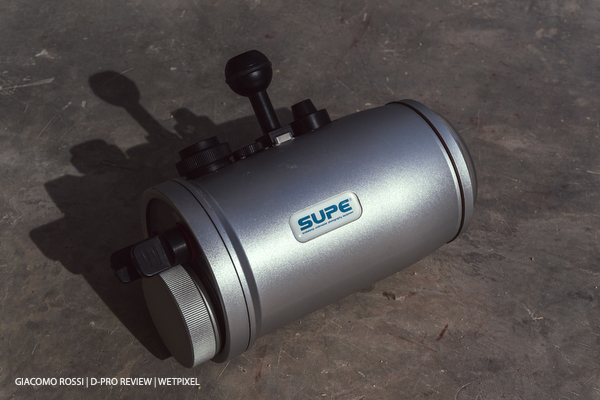
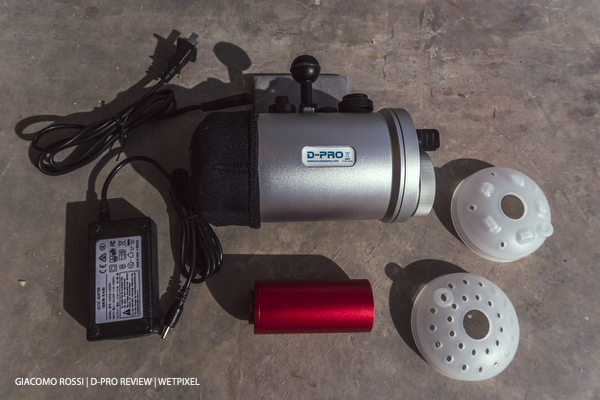
FTTC disclosure:
Scubalamp D-Pro was purchased by Giacomo Rossi at a discounted price for evaluation of the new product and further personal use. The D-MAX is the actual strobe used by Giacomo Rossi, and the Retra Pro was lent by Scipione Mannaccio Soderini for this test.
First look and main characteristics
Opening the box, we can find the new D-PRO along with two different diffusers, a new impressive big red battery, a charger, and the ball mount. My version doesn’t yet have the neoprene cover to improve the neutral buoyancy, but the production version will ship with one. The pre-production model has a slimmer design, a new bulb, new controls with a nice LCD display, and a completely new battery.

On the back, we find two knobs, one to switch the strobe on and activate the 500 lumens focus light, and the second to select the power level. Like the D-MAX we have 8 levels of output power. The T level is just to test the strobe, with one lamp at maximum power.
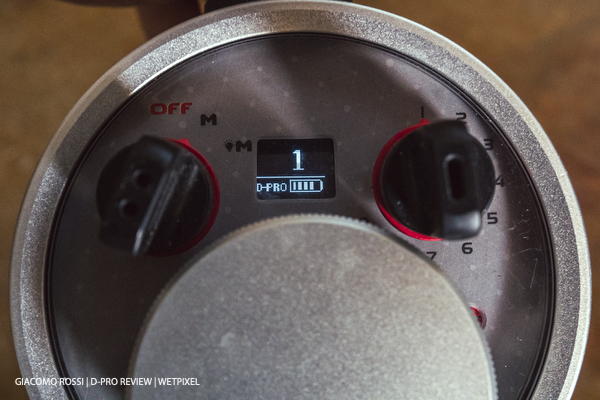
The new battery compartment is now sealed and isolated from the main electronics. This is a very nice feature that I was looking for.
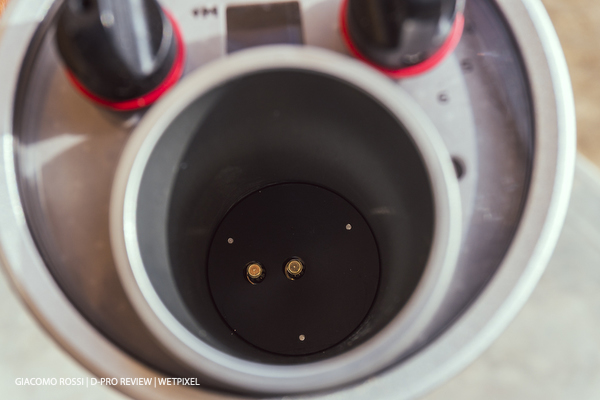
There is now an LCD display featuring a battery charge indicator that will help the diver to monitor the amount of battery life available. I consider this feature very useful, especially as we often plan to do 3 or 4 dives per day. We now know if it is necessary to change or charge the battery in between dives, or if the amount of charge will be enough. The battery itself is very capable, with more than 500 cycles at maximum power, and more than a thousand at low power. Also, the battery charges in just a couple of hours using the new fast 2.8 Amp charger compared to the 2 Amp of the previous version.
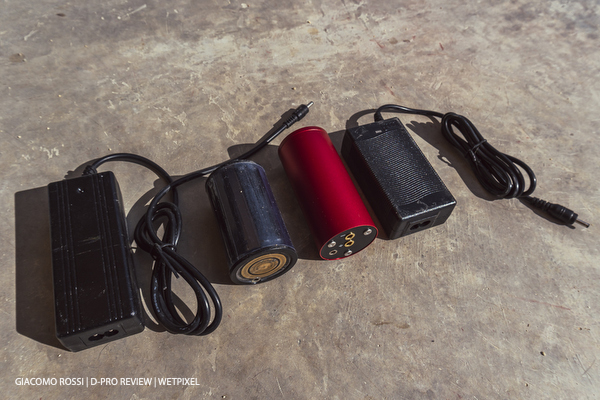
The new D-PRO weighs 1080g without a battery and 1300g with it. The D-MAX was 1465 with the battery, so the “diet” has reduced its weight to 165 grams. But what is most important is the overall size. Now the maximum diameter is just 90 mm and the handling is much better compared to the D-MAX.
Another significant difference is the flash tube, which is now smaller, and the front glass dome which looks more curved. The focus light is still in the center with a power of 500 lumen.
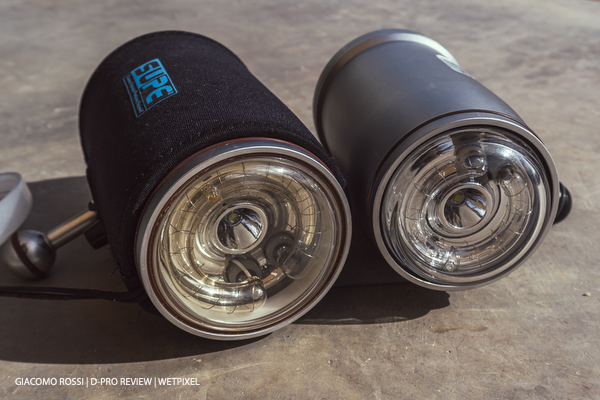
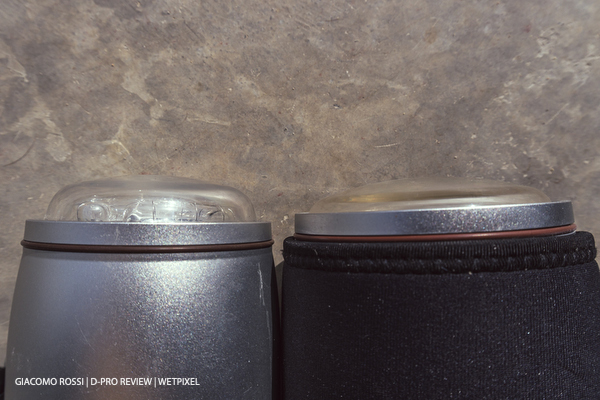
To the side of the ball mount s located the fiber optic connector, the sync port, and finally a second fiber optic port that is used when the camera, like many compact ones, produces a pre-flash. The D-MAX was not designed for cameras that have an integrated flash and without the option to deactivate the pre-lamp. Now it’s possible to use this powerful flash with compact cameras.

The diffusers and we have two different designs for them, are attached to the strobe using a groove and an O-ring. This is the same design as on the previous model. Now the diffusers also have an input port for a fiber optic cable. This is useful for triggering another strobe.
To resume, the main differences between the D-PRO and D-MAX are:
- Smaller
- Lighter
- More output power
- Battery compartment sealed
- LCD display to check the battery level
- Second fiber optic port for compact cameras with pre-lamp
Below are the full specifications of the D-PRO (SUPE source)
- Guide number: 30
- Flash tube: circular
- Power: 160 Ws
- Connection: fibre optic / 5 pin sync cable
- Output beam: 150 degrees
- Power levels: 1-8 plus test mode
- Battery: SUPE battery (3x18650 Lithium) of 37.8 Wh
- Flash capacity: 500 at maximum power – 3000 at minimum power
- Recycle time: 0.1 sec at minimum power, 1.1s at maximum power
- Burst capacity: unlimited at 10 flash/second at minimum power level.
- Power indicator: LCD display
- Colour temperature: 4800 K
- Max depth: 100m
- Focus light: 500 lumens (centric)
- Dimensions: 170 x 90 mm
- Weight: 1080 g without battery, 1300 g with battery
- Weight underwater (without neoprene cover): 120 g
- TTL: Not compatible with
Impressions and real-world performances
The new D-PRO from its first appearance appears to be a mature product, with all the improvements we were seeking with the first version.
I did a real-world test, and not a lab test. I didn’t measure the actual output power in Ws, but I did a real comparison with the D-MAX and a Retra Pro belonging to a friend of mine, comparing the power, color temp, uniformity of illumination, and speed.
I started with a pool test to check the power and quality of light. The D-PRO now produces powerful illumination with a great color temperature and quality of illumination.
In the images below, it is easy to see the improvements of the D-MAX and how close the performance is now to the excellent Retra Pro.

The pool test tells us that the color temperature is close to 4800 K, producing more pleasant blue colors. The output power also is very similar to the Retra Pro, marking a big step forward for SUPE.
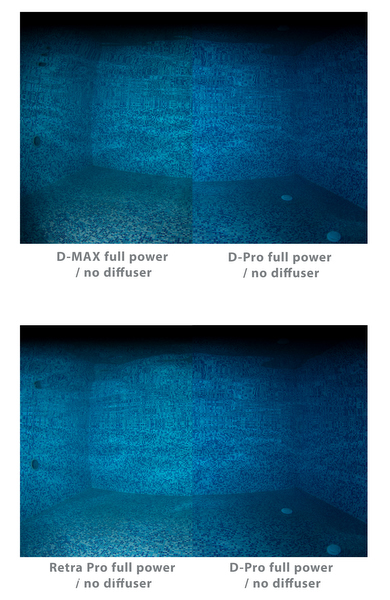

The output spectrums between the D-PRO and RetraPro are very similar. The improvements over the spectrum quality of the D-MAX are obvious.
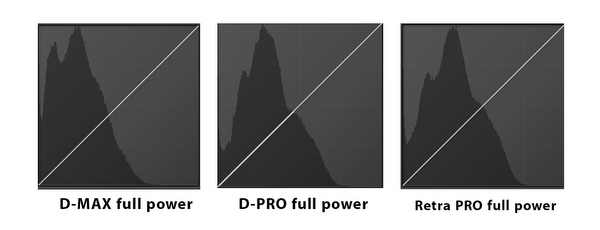
The output beam is also very wide and in my pool test, I didn’t find any significant differences in terms of beam angle with or without the diffusers.
Without the diffusers, the output beam angle is around 150-160 degrees. What is impressive is that, even with a high output beam angle, the global power is close to that of the Retra Pro.
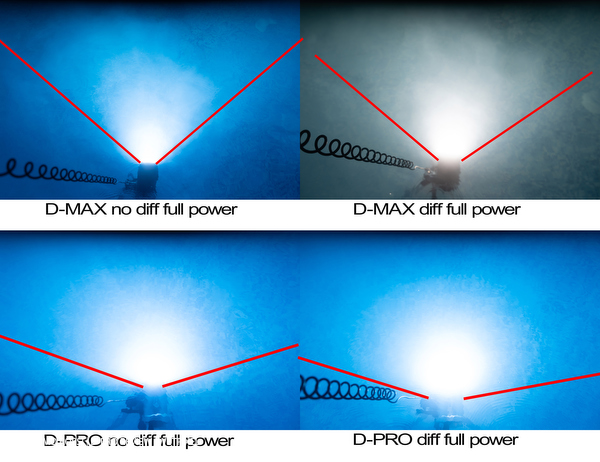
Thanks to the powerful battery, it is possible to cycle at full power without so many concerns and at a reasonably high speed. My test has found that the D-PRO can fire at maximum power at 2 shots per second for 9 consecutive shots without black frames. At the speed of 3 shots per second, it can fire for 3 consecutive flashes before having a black frame.
In the following table, I report the recycling time that I found during my test:
| Power Level | lamps/second | Recycle time (s) | No. consecutive flashes |
|---|---|---|---|
| 1 min power | >10* | 0.1 | No Stop |
| 2 | 10 | 0.1 | No Stop |
| 3 | 6.5 | 0.2 | No Stop |
| 4 | 3.5 | 0.28 | No Stop |
| 5 | 3 | 0.3 | No Stop |
| 6 | 2.5 | 0.4 | No Stop |
| 7 | 2 | 0.5 | No Stop |
| 8 max power | 2 | 0.5 | 9 |
*the setup used doesn’t permit reaching trigger speed faster than 10 bps. I have used an app on my mobile phone that can fire in precise timing the camera led.
These results are impressive to me and mark a big step forward compared to the D-MAX.
With this performance, now it will be possible to fire at maximum power at a high speed without losing a shot. At minimum power, it will be possible to shoot at the same speed of modern cameras in burst mode, around 7+ fps.
During the test, it has not been possible to measure with precision the output power of every shot in a burst. There is a variation of power shot after shot, especially if the output power is greater than level 5. I found this during my post-processing of some shots taken at 5 fps using my Sony A7IV with two D-PRO at 6 power levels.
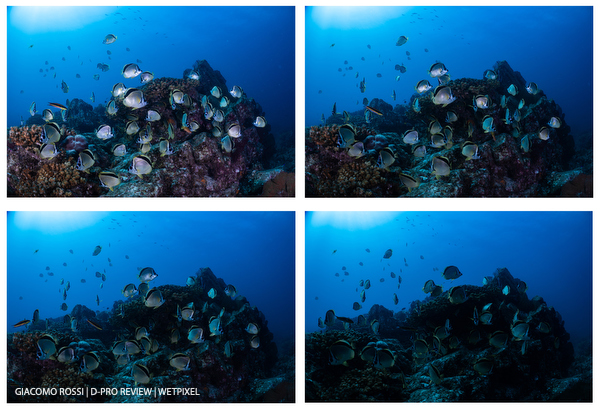
After this test, I forwarded my impressions to Raymond, of Scuba Lamp. He commented to me that some small issues, like the power variation during the burst, have been fixed for the production version. This is a very important point that I cannot verify personally currently.
Real-world impressions
I tested the strobes during my dives at Cerralvo Island, in front of La Ventana. The dive conditions right now are very challenging for wide photography due to increased particles in the water column, and lower visibility compared to the ideal conditions in the summertime. Even in these conditions and considering the ultra-wide output beam of the new D-PRO, I had very good results. I appreciated the improved recycling time and quality of illumination. Overall, the new strobe gave me a much better feeling, that sometimes it is difficult to quantify with a number.
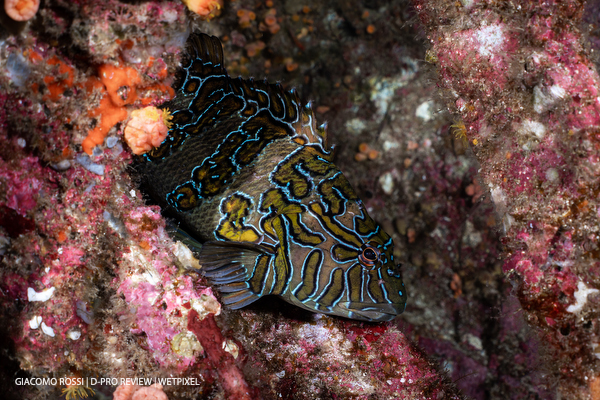
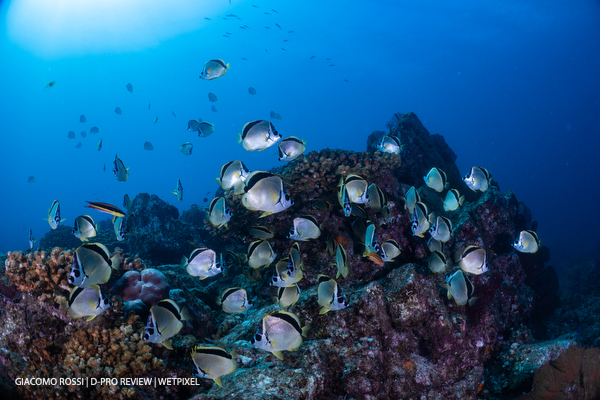
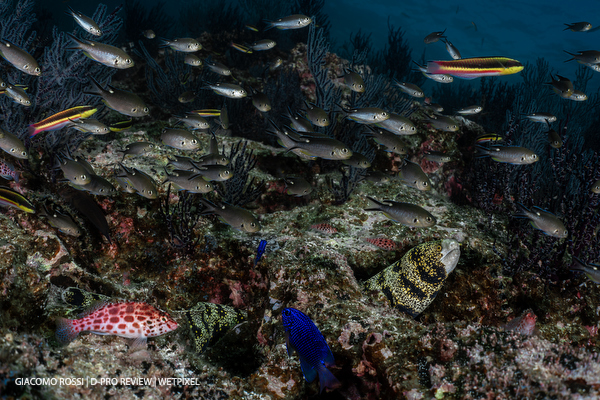
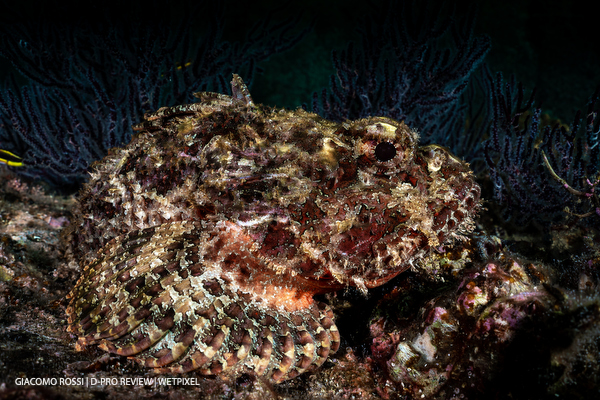
Conclusions
With this latest version of their strobe, the D-PRO, Scuba Lamp did great work, improving almost all aspects. Now we have a more mature product that can compete well in the strobe market. With a reduced size and weight, improved quality of light and power, faster cycle times, and improved reliability thanks to its sealed battery compartment. It also now has the additional capability of compatibility with compact cameras, the D-PRO is for sure an excellent product.
Personally, I was waiting for some improvement over the D-MAX, and I must admit that Scuba Lamp has surprised me in almost all aspects.
Considering that the selling price is much lower than the competitors, the D-PRO could become a winner in the strobes market.
Obviously, there are some small details that can be improved, like a better-shaped front dome to have a slightly narrower output beam. I consider that 150+ degrees now is too much, and in certain circumstances, it becomes difficult to avoid the backscatter. The diffuser connection system could be improved with a more reliable one, and maybe have two different shapes and sizes for the control knobs, to avoid switching off the strobe during the attempt to change the output power.
If I must give a score to this product, on a scale of 10, I will aware of the new D-PRO with a round 8. I really loved this new toy!
Giacomo Rossi
Giacomo is an underwater photographer and dive instructor with a great passion for pelagic animals. His passion first developed in the Red Sea during his job as a dive guide on a liveaboard back in 2009. During these early stages, he focused mainly on underwater videography before eventually switching to photography.
He has been living in Mexico since 2011, first in Cozumel, and now in La Paz, Baja California Sur, where he was able to improve on his wide-angle imagery while capturing the large pelagic animals of the Pacific Ocean and Sea of Cortez. Some trips to Indonesia, the South Pacific, and other popular dive destinations gave him further subjects to feed his passion. The purpose of his photography is to transmit this passion for the ocean and its inhabitants and inspire people to help in its conservation. This is also the mission of his company Baja Underwater Expeditions, which offers personalized eco-tourism around the peninsula to experience all of its most exciting residents and visitors up close and personal.